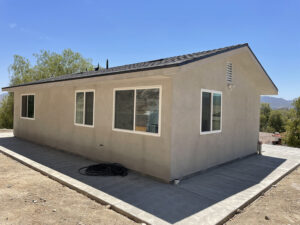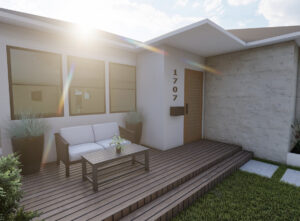There is a lot of untapped potential out there to increase housing supply. Many homes in cities are underutilized due to their single-family design where they could be easily converted into ADUs. ADUs stand for accessory dwelling units, which include detached, independent small homes that share the property with main house. ADUs are also called granny flats, backyard cottages, or in-law apartments. These properties can provide housing to seniors who want to stay close to their families, but some cities find it hard to expand housing supply due to various regulations and zoning laws around ADU construction.
Many people that are taking advantage of ADUs are using them as rental properties. This is a great way to start your investment portfolio because the competition is low, and you can get a good return on your money. That said, as an entrepreneur that wants to invest in real estate in this way, you need to consider whether ADU rentals are right for you. Below are five simple steps that will help you decide whether you should get into this business.
Determine your local zoning laws and policies regarding renting out ADUs.
This is a big question in most cities, which might have very strict laws on when, where, and how many times the property can be used as a rental. Some cities allow you to rent out the ADU but not past a certain date, such as only during vacation periods. The other side of the spectrum is when it’s completely illegal in your area to rent out an ADU and all its features to someone else (utilities, parking, etc.). Check with your local government on what exactly you can and can’t do with respect to renting out your ADU.
Determine how much monthly income you want through rental property.
It’s not uncommon for a single-family home with the addition of an ADU to make about $1,000 per month in rent. When determining how much you should charge for rent, consider how much your time is worth. If you’re going to be doing a lot of things yourself (such as painting, repair work, and cleaning), then you should decrease the amount a little bit in order to make up for that loss of time. But if you plan on hiring people to do work on the property itself—that’s not really related to the rental (such as renting out a detached garage)—then you should charge more to make up for additional expenses.
Determine if you even want to be a landlord or not.
While being a landlord can be profitable, it requires a lot of time and money in order to maintain. For example, let’s say that your tenant calls you at a bad time and leaves an urgent message about needing to get into the house. Well, if you’re already out of town or busy doing other things, then it could take hours before you are able to respond to them and solve the issue, they need help with. Or what if someone moves into and breaks something? Who’s going to pay for it? This is just a small list of some of the problems with being a landlord, and you need to know that it can be more work than benefit.
Determine who will live in your ADU.
This step revolves around the question: Will you even use this as an apartment or rental? Some people choose to rent out their ADU to a family member that can help keep the house looking nice, whereas others choose to rent out to anyone just for the sake of making more money. No matter what your reason is, decide if you’re going to be friendly with this tenant or not in order to make things easier when it comes time for rent checks and repairs.
Determine if you can live with your choices.
It’s not uncommon for someone to choose to rent out their ADU, only to realize afterwards that they really didn’t want to be a landlord in the first place. For example, what happens when the tenant moves out? Are you going to do all the cleaning and repairing on your own? If you aren’t planning to do so, then the whole ordeal might just be more work than it’s worth. Or what if something happens—like a sink break or a wall crack—on the property that requires repairs? Can you live with these and other problems as they arise, or are you going to get fed up and start losing money because you can’t keep up with the finances?
Determine if you can handle being a landlord. Act.
The best way to determine whether investing in an ADU is right for you is to go out and start by renting it out for one month. If everything goes as planned, then great! You’re off to the races and can start marketing your property in order to attract more tenants. But if things don’t go as planned, then you need to make some changes or halt renting out the ADU all together if it’s a hassle or problem for you. Know that there are always pros and cons with everything, but at least you know what those pros and cons could be in the process of renting out your ADU.
If you are able to handle these points, then you should have no problem becoming a landlord with an ADU. But if there is any doubt at all—or if some of those things sound like they’ll be too much work for you—then it’s best to investigate other alternatives (such as renting out a guest house on Airbnb or similar).
TIP: Make sure you make this decision with your significant other and/or family. This is going to be something that affects the entire household, so it’s important to know if everyone can handle the extra work and expenses.
If you’ve decided that you’d like to become a landlord with an ADU, then you’ll need to get yourself prepared for it. This can be done easily by taking these five simple steps and focusing on the future rather than dwelling in the past.
Now that you know how to start generating money from your ADU, it’s time to act!
Step 1: Start doing research.
It’s best if you go out and do your own research for this step, which is why it comes first in the process. Research some local rental prices for similar properties that are around your area so that you’ll know what kind of rent to shoot for (this varies depending on a myriad of factors). Write this rent amount in your notebook and write down ways that you can market the property to renters.
Knowledge is very powerful; once you have it, you can control your financial future with more confidence than ever before. So, remember to keep researching as often as possible! For example, if your first tenant tells you that the air conditioner is broken, then make sure to research how much it will cost you to fix it.
Step 2: Find what you’re looking for.
If your goal was never really to rent out an ADU, then chances are good that you’ve already found something else by now. But if not, then keep trying. Use the tips in my article titled 6 ways to find your next property fast for searching for and finding a good investment.
Step 3: Put your plan into action.
Now that you’ve got a place to put your ADU, it’s time to start making plans. Start drafting things like blueprints of the unit, floor plans, and other forms of planning. Put these into action by hiring contractors, if necessary (for example, you might need to hire a plumber to install a new sink or toilet in there).
Step 4: Rent it out!
Once your unit is all completed with the repairs and construction that are needed—and once you’ve done some research on putting the best price out there—then it’s time to start marketing your property. Some ways that you can do this are by renting off services like Craigslist or Zillow, or by using more creative solutions such as an Airbnb short-term rental.
Step 5: Enjoy the fruit of your labor!
The hard part is over now, so you should be able to enjoy the fruits of your labor by receiving your monthly rent checks. Some months will be better than others—this is natural—but at least the hard work that came before it will have paid off in a big way!







